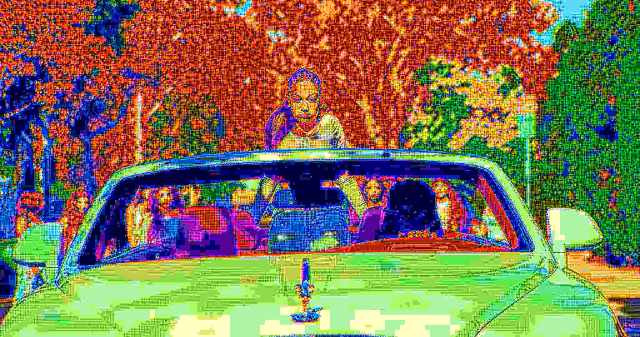Difference between revisions of "WorkUnit:Carnages, frame per frame compressions"
Frankiezafe (Talk | contribs) (→screenshots) |
Frankiezafe (Talk | contribs) (→sound) |
||
| Line 162: | Line 162: | ||
== sound == | == sound == | ||
| − | First attempt using [http://lame.sourceforge.net/ lame]. | + | First attempt using [http://lame.sourceforge.net/ lame], [[File:I_got_it_3.mp3]] |
| − | <html>< | + | <html> |
| + | <audio controls style="width:100%"> | ||
| + | <source src="https://frankiezafe.org/images/0/00/I_got_it_3.mp3"> | ||
| + | </audio> | ||
| + | </html> | ||
=== script === | === script === | ||
Revision as of 21:55, 28 May 2018
Automatised post-processing of video using image compression algorithm glitches.
screenshots
Lorn, Acid Rain
Bhad Bhabie, I got it
video
process
For jpg codec, the process is recompressing each frame with 1% less quality than previous compression. In the videos above, we start at 40% and gradually decrease the quality to 1%.
For gif codec, it is much more straight-forward, as we do the process in one pass, specifying the number of colors in the palette.
Python script
try:
from cStringIO import StringIO as BytesIO
except ImportError:
from io import BytesIO
from PIL import Image
import os
import shutil
import subprocess
------------- GLOBAL -------------
# set to true if the source video has not been extracted already
regenarate_video_frames = False
recompress_video_frames = True
regenarate_output_video = True
# source video path
video = 'source.mv'
# folder path to export source video frames
folder_frames = 'frames'
# folder path to store compressed video frames
folder_compressed = 'compressed'
# type of compressor - JPG or GIF
compressor = 'JPG'
# jpg compressor settings
jpg_from = 40
jpg_to = 1
jpg_steps = 1
# gif compressor settings
gif_colors = 4
# output frames limits
limit_from = 1800
limit_to = 3125
# output frame rate
fps = 25
fprefix = 'output_'
------------- FUNCTIONS -------------
def create_folder(p):
if not os.path.exists(p):
os.makedirs(p)
else:
clear_folder(p)
def clear_folder(p):
for root, dirs, files in os.walk( p ):
for f in files:
os.unlink(os.path.join( root, f ))
for d in dirs:
shutil.rmtree(os.path.join( root, d ))
def jpg_compress( src_path, dst_path ):
jpg_q = jpg_from
while jpg_q >= jpg_to:
src = Image.open( src_path )
buffer = BytesIO()
src.save( buffer, "JPEG", quality = jpg_q, optimize=True, progressive=True )
jpg_q -= jpg_steps
buffer.seek(0)
with open( dst_path, "w") as handle:
handle.write(buffer.read())
src_path = dst_path
def gif_compress( src_path, dst_path ):
src = Image.open( src_path )
buffer = BytesIO()
src = src.convert('P', palette=Image.ADAPTIVE, colors=gif_colors)
src.save( buffer, "PNG" )
buffer.seek(0)
with open( dst_path, "w") as handle:
handle.write(buffer.read())
------------- PROCESS -------------
if regenarate_video_frames == True:
create_folder( folder_frames )
subprocess.call(['ffmpeg', '-i', video, '-vcodec', 'png', folder_frames + '/' + fprefix + '%05d.png' ])
if recompress_video_frames == True:
create_folder( folder_compressed )
ext = '.jpg'
if compressor == 'GIF':
ext = '.png'
for root, dirs, files in os.walk( folder_frames ):
files.sort()
i = 0
outi = 0
for f in files:
if limit_from > -1 and i >= limit_from and i < limit_to:
outf = folder_compressed + '/' + fprefix
if outi < 10:
outf += '0000'
elif outi < 100:
outf += '000'
elif outi < 1000:
outf += '00'
elif outi < 10000:
outf += '0'
outf += str(outi) + ext
outi += 1
if compressor == 'JPG':
jpg_compress( folder_frames + '/' + f, outf )
elif compressor == 'GIF':
gif_compress( folder_frames + '/' + f, outf )
print( str( outi ) + '/' + str( ( limit_to - limit_from ) ) + ' frame (' + ext + ')' )
i += 1
if regenarate_output_video == True:
movie_path = 'movie_' + fps + 'fps_' + limit_from + '-' + limit_to
im_path = folder_compressed + '/' + fprefix + '%5d'
if compressor == 'JPG':
movie_path += '_' + jpg_from + '-' + jpg_to + '-' + jpg_steps + 'jpg'
im_path += '.jpg'
elif compressor == 'GIF':
movie_path += '_' + gif_colors + 'gif'
im_path += '.png'
else:
pass
movie_path += '.mkv'
subprocess.call(['ffmpeg', '-f', 'image2', '-framerate', str(fps), '-r', str(fps), '-i', im_path, '-an', '-vcodec', 'mjpeg', '-q:v', '1', folder_compressed + '/' + movie_path ])
sound
First attempt using lame, File:I got it 3.mp3
script
try:
from cStringIO import StringIO as BytesIO
except ImportError:
from io import BytesIO
from PIL import Image
import os
import shutil
import subprocess
source = 'source.wav'
swap_file1 = 'output.mp3'
swap_file2 = 'output2.wav'
passes = 27
freq = 20001
freq_gap = 300
scale = 1.03
compression = 20
compression_gap = 1.3
FNULL = open(os.devnull, 'w')
subprocess.call(['lame', '--quiet', '-q', '9', source, swap_file1 ])
for i in range( 0, passes ):
print( '>>>>>>>>>>> pass: ' + str( i ) + ', freq: ' + str(freq) + ', compression: ' + str(compression) )
subprocess.call(['ffmpeg', '-i', swap_file1, '-ar', str(freq), '-loglevel', 'panic', '-y', swap_file2 ])
subprocess.call(['lame', '--scale', str(scale), '--quiet', '-q', '9', '--comp', str(compression), swap_file2, swap_file1 ])
if i%2 == 1:
freq -= freq_gap
else:
freq += freq_gap
compression += compression_gap
# preview
subprocess.call(['xplayer', swap_file1], stdout=FNULL, stderr=subprocess.STDOUT)











